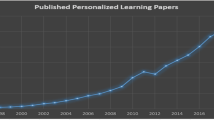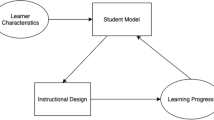Abstract
The growth usage of mobile technologies and devices such as smartphones and tablets, and the almost ubiquitous wireless communication set the stage for the development of novel kinds of applications. One possibility is exploiting this scenario in the field of education, so creating more intelligent, flexible and customizable systems. Mobile devices can be used to help students to learn, considering their learning styles, surroundings, devices and profiles. In this way, the main goal of this article is to propose EduAdapt, an architectural model for the adaptation of learning objects considering device characteristics, learning style and other student’s context information. To make this adaptation we used inferences and rules in a proposed ontology, named OntoAdapt. We believe that such ontology can help recommending learning objects to students or adapt these objects according to the context (context-aware computing). We evaluate this proposal in two ways. Firstly, we used scenarios and metrics to assess the ontology. Secondly, we developed a prototype of EduAdapt model and submitted to a class of 20 students with the intention of evaluating the usability and adherence to adapted objects, resulting in a 78 % of acceptance. In brief, the evaluation presented encouraging results, indicating that the proposed model would be useful in the learning process.




















Similar content being viewed by others
Notes
At the moment the only conversion of this type possible uses the tool available at https://github.com/weidagang/text-diagram.
References
Ahmad IA (1996) A class of Mann–Whitney–Wilcoxon type statistics. Am Stat 50(4):324–327. doi:10.1080/00031305.1996.10473561
Akbulut Y, Cardak CS (2012) Adaptive educational hypermedia accommodating learning styles: a content analysis of publications from 2000 to 2011. Comput Educ 58(2):835–842. doi:10.1016/j.compedu.2011.10.008
Andrade Menolli AL, Reinehr S, Malucelli A (2012) Ontology for organizational learning objects based on LOM standard. In: 2012 XXXVIII Conferencia Latinoamericana En Informatica (CLEI). IEEE, pp 1–10. doi:10.1109/CLEI.2012.6427194
Bachir Bouiadjra A, Benslimane S (2011) Foeval: full ontology evaluation. In: 2011 7th international conference on natural language processing and knowledge engineering (NLP-KE), pp 464–468. doi:10.1109/NLPKE.2011.6138244
Bellavista P, Corradi A, Fanelli M, Foschini L (2012) A survey of context data distribution for mobile ubiquitous systems. ACM Comput Surv 44(4):1–45. doi:10.1145/2333112.2333119
Bergner I, Baumgartner P (2003) Educational models and interaction patterns for instruction—an example for LOM categorization. http://peter.baumgartner.name/wp-content/uploads/2012/12/Bergner_Baumgartner_2003_Educational-Models-and-Interaction-Patterns-for-Instruction.pdf
Brusilovsky P, Millán E (2007) User models for adaptive hypermedia and adaptive educational systems. In: Brusilovsky P, Kobsa A, Nejdl W (eds) The adaptive web, vol 4321, chap user models for adaptive hypermedia and adaptive educational systems. Springer, Berlin, pp 3–53
Chen H, Finin T, Joshi A (2005) Semantic web in the context broker architecture. In: Proceedings of PERCOM 2004, pp 277–286
Chu HC, Hwang GJ, Tsai CC, Tseng JC (2010) A two-tier test approach to developing location-aware mobile learning systems for natural science courses. Comput Educ 55(4):1618–1627. doi:10.1016/j.compedu.2010.07.004
Dey AK (2001) Understanding and using context. Pers Ubiquitous Comput 5(1):4–7. doi:10.1007/s007790170019
Duval E, Tom W, Hodgins HW (2002) Draft standard for learning object metadata. IEEE 1484:1–2002. doi:10.1109/IEEESTD.2002.94128
Felder RM, Silverman LK (1988) Learning and teaching styles in engineering education. Eng Educ 78(June):674–681
Franzoni A, Assar S (2008) Student learning styles adaptation method based on teaching strategies and electronic media. Educ Technol Soc 12:15–29. http://ieeexplore.ieee.org/xpls/abs_all.jsp?arnumber=4561832
García-Peñalvo F (2011) Analysis of the owl ontologies: a survey. Sci Res Essays 6(20):4318–4329. doi:10.5897/SRE11.1036
Gliem J, Gliem R (2003) Calculating, interpreting, and reporting Cronbach’s alpha reliability coefficient for Likert-type scales. In: Midwest research-to-practice conference in adult, continuing, and community education, 1992, pp 82–88. https://scholarworks.iupui.edu/handle/1805/344
Gómez S, Zervas P, Sampson DG, Fabregat R (2013) Context-aware adaptive and personalized mobile learning delivery supported by UoLmP. J King Saud Univ Comput Inf Sci. doi:10.1016/j.jksuci.2013.10.008
Han Q, Gao F, Wang H (2010) Ontology-based learning object recommendation for cognitive considerations. In: World congress on intelligent control and automation (60921003), pp 2746–2750. doi:10.1109/WCICA.2010.5554857
Henze N, Dolog P, Nejdl W (2004) Reasoning and ontologies for personalized e-learning in the semantic web. Educ Technol Soc 7:82–97
Horridge M, Aranguren ME, Mortensen J, Musen M, Noy N (2012) Ontology design pattern language expressivity requirements. In: Blomqvist E, Gangemi A, Hammar K, Suárez-Figueroa MC (eds) Workshop on ontology patterns (WOP), vol 929
Hsu C, Ho C (2012) The design and implementation of a competency-based intelligent mobile learning system. Expert Syst Appl 39(9):8030–8043. doi:10.1016/j.eswa.2012.01.130
Likert R (1932) A technique for the measurement of attitudes, vol 140. The Science Press, New York
Mccown F, Nelson ML (2006) Search engine coverage of the OAI-PMH corpus. In: IEEE International Computing (April), pp 66–73. http://ieeexplore.ieee.org/xpls/abs_all.jsp?arnumber=1607990
Moreno JER (2012) Adaptation of learning strategies in learning objects for using learning styles. IERI Procedia 2:808–814. doi:10.1016/j.ieri.2012.06.175
Noy N, McGuinness DL (2001) Ontology development 101: a guide to creating your first ontology. Knowledge Systems Laboratory, Stanford University. http://protege.stanford.edu/publications/ontology_development/ontology101.pdf
Ouyang L, Zou B, Qu M, Zhang C (2011) A method of ontology evaluation based on coverage, cohesion and coupling. In: Fuzzy systems and knowledge discovered (FSKD). IEEE, pp 2451–2455
Parupalli R, Nelaturu SCB, Jain DK (2011) The role of content adaptation in ubiquitous learning. In: 2011 IEEE international conference on technology for education, pp 177–182. doi:10.1109/T4E.2011.35
Pernas AM, Diaz A, Motz R, Oliveira JPMD (2012) Enriching adaptation in e-learning systems through a situation-aware ontology network. Interact Technol Smart Educ 9(2):60–73. doi:10.1108/17415651211242215
Peterson ER, Rayner SG, Armstrong SJ (2009) Researching the psychology of cognitive style and learning style: Is there really a future? Learn Individ Differ 19(4):518–523. doi:10.1016/j.lindif.2009.06.003
Qadir MA (2010) Algorithms to evaluate ontologies based on extended error taxonomy. In: 2010 International conference on information and emerging technologies, pp 1–6. doi:10.1109/ICIET.2010.5625707
Romero L, Godoy R (2010) An ontology for semantic definition of learning objects. In: 2010 5th Iberian conference on information systems and technologies (CISTI), pp 1–7
Satyanarayanan M (2010) Mobile computing. In: Proceedings of the 1st ACM workshop on mobile cloud computing and services social networks and beyond—MCS ’10, pp 1–6. ACM Press, New York, New York, USA. doi:10.1145/1810931.1810936
Ssemugabi S (2009) Usability evaluation of a web-based e-learning application: a study of two evaluation methods. Ph.D. thesis
Staab S, Studer R, Schnurr HP, Sure Y (2001) Knowledge processes and ontologies. IEEE Intell Syst 16(1):26–34. doi:10.1109/5254.912382
Su JM, Tseng SS, Lin HY, Chen CH (2011) A personalized learning content adaptation mechanism to meet diverse user needs in mobile learning environments. User Model User Adapt Interact 21(1–2):5–49. doi:10.1007/s11257-010-9094-0
Triola M (2011) Elementary statistics. Pearson Learning Solutions. http://books.google.es/books?id=3C9VYgEACAAJ
Vrandeĉić D (2009) Ontology evaluation. In: International handbook on information systems. Springer, pp 293–313
Wagner A, Barbosa JLV, Barbosa DNF (2014) A model for profile management applied to ubiquitous learning environments. Expert Syst Appl 41(4, Part 2):2023–2034. doi:10.1016/j.eswa.2013.08.098
Yarandi M, Jahankhani H, Tawil A (2012) An ontology-based adaptive mobile learning system based on learners’ abilities. In: Proceedings of the 2012 IEEE global engineering education conference (EDUCON). IEEE, pp 1–3. doi:10.1109/EDUCON.2012.6201115
Zhao X, Wan X, Okamoto T (2010) Adaptive content delivery in ubiquitous learning environment. In: 2010 6th IEEE international conference on wireless, mobile, and ubiquitous technologies in education, pp 19–26. doi:10.1109/WMUTE.2010.10
Acknowledgments
The authors would like to thank National Council for Scientific and Technological Development - CNPQ and GVDASA Sistemas (http://www.gvdasa.com.br) for financial support which made possible the development of this work.
Author information
Authors and Affiliations
Corresponding author
Rights and permissions
About this article
Cite this article
Abech, M., da Costa, C.A., Barbosa, J.L.V. et al. A model for learning objects adaptation in light of mobile and context-aware computing. Pers Ubiquit Comput 20, 167–184 (2016). https://doi.org/10.1007/s00779-016-0902-3
Received:
Accepted:
Published:
Issue Date:
DOI: https://doi.org/10.1007/s00779-016-0902-3




